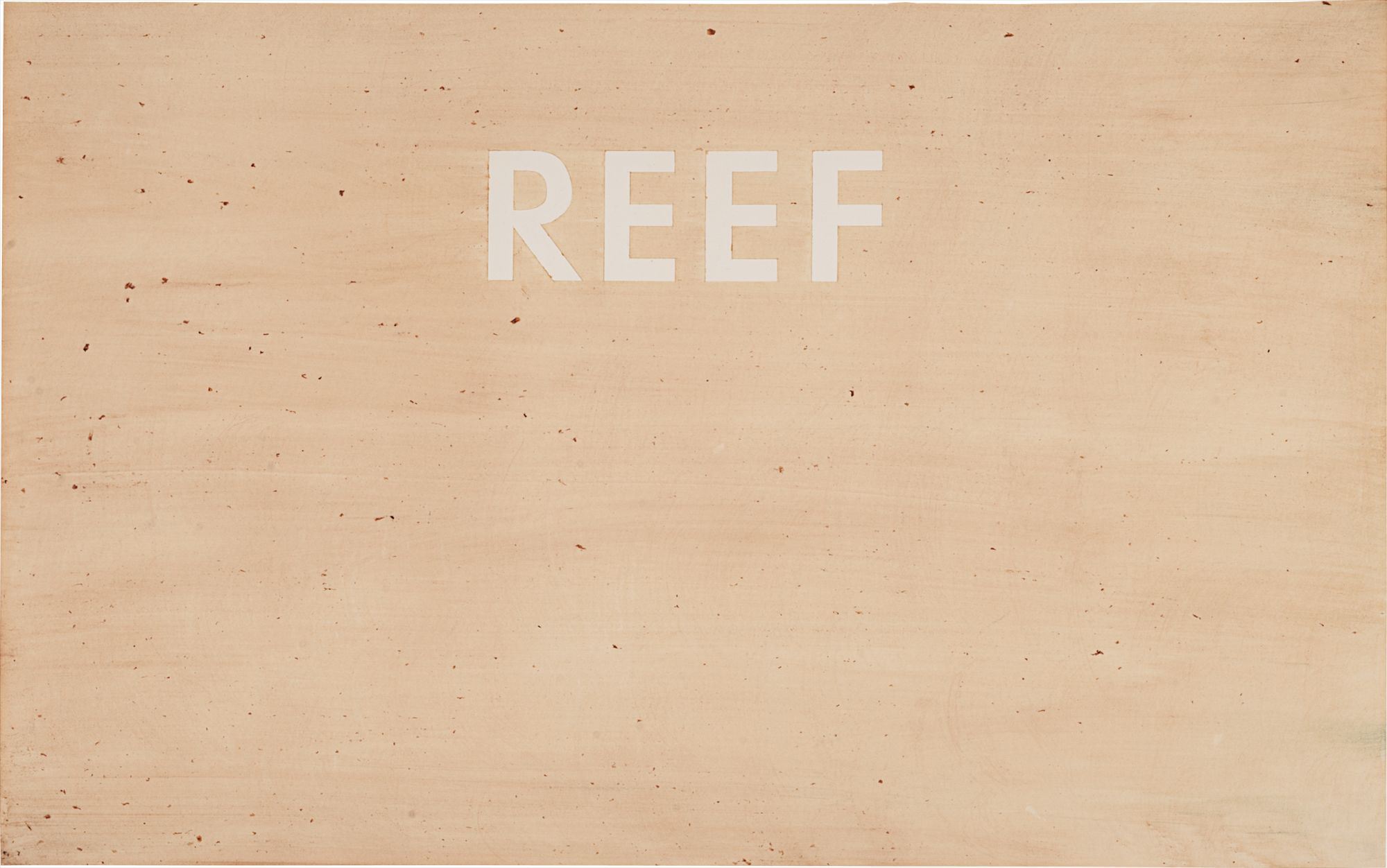

20
Ed Ruscha
Reef
Full-Cataloguing
The integral role of text in Ruscha’s works is explained by his fascination with the vernacular: “I love the language. Words have temperatures to me. When they reach a certain point and become hot words, then they appeal to me.” (Artist biography: Ed Ruscha, www.famouspopartists.wordpress. com 15 June, 2011). His interest in experimenting with words and phrases began in the early 1960’s. His choice of extracts is often centred on their comical and particularly satirical characteristics. The inspiration for his statements is spontaneous and unconscious: “Well, they just occur to me; sometimes people say them and I write down and then I paint them. Sometimes I use a dictionary.” The interchange between the use of a single, emphatic word and the presentation of an entire phrase can been seen to represent Ruscha’s transition into his involvement in the post Pop-Art movement, beginning it the 1980’s, where artists characteristically began to use entire phrases in their works. The emphatic use of the one word in this piece, however, applies to preceding period in his work: “Single words kept my interest for a while and then, later, there was only one thing to do – heap more words in.” This lot represents an integral period in the artist’s repertoire where he dissects language and fully explores the basis on which the rest of his oeuvre is based. Ruscha’s return to inception can be seen in the presentation of the single element but also further in the deconstruction of the word itself: “I always looked at a word like it was a horizontal bunch of abstract shapes, which is really what it is.” (J. Lindblad, Ed Ruscha Fify Years Of Painting, 2 September, 2010, www.artobserved. com). The explanation for his choice, therefore, becomes complicated to decipher. The agency of his paintings seems to lie in the adaptation of language from a means of communication to a symbolic object, almost attaining the qualities of a ready-made. The word ‘Reef’, powerful in its use of capital letters, enveloping consonants and repetition of vowels, results in the creation of an abstract shape rather than a literary meaning. Ruscha defines this change in objective as a means of purveying “the visual noise of words”, allocating them the ability to “cry out” and naturally highlighting their potential as a works of art rather than remaining constricted by their academic meaning. Reef, though ambiguous in precise meaning, presents a powerful and profound image to the viewer. The stark white text emerging from the monochrome background acts as a trigger for the viewer. The short, powerful text emerges from the banality of its surroundings and emphasises the importance of comparison and association rather than relying on a primary level. Ruscha states: “At one time I used to think that art was strictly visual, and you’re not supposed to go and dig deeper into messages. But now I believe it all has to do with tantalising your memory”. His works are designed to create a unique reaction in the audience and to incite their own interpretation and reaction to the painting. It remains unexplained and undirected: “The most an artist can do is to start something and not give the whole story. That’s what makes mystery.”
Ruscha’s work strips modern, commercialised life back to the source, the foundations of thought and stimuli: “I like to think the California sun has burnt out all unnecessary elements in his work,” states film director David Lynch (Rachel Cooke, Ed Ruscha: There’s room for saying things in bright shiny colours, The Guardian, 12 September 2010). Ruscha is a poet of the art world, his work is simplistic yet powerful “I guess that’s what poets want to do: put ideas on stage. I settle for a single word.”
Ed Ruscha
American | 1937Quintessentially American, Ed Ruscha is an L.A.-based artist whose art, like California itself, is both geographically rooted and a metaphor for an American state of mind. Ruscha is a deft creator of photography, film, painting, drawing, prints and artist books, whose works are simultaneously unexpected and familiar, both ironic and sincere.
His most iconic works are at turns poetic and deadpan, epigrammatic text with nods to advertising copy, juxtaposed with imagery that is either cinematic and sublime or seemingly wry documentary. Whether the subject is his iconic Standard Gas Station or the Hollywood Sign, a parking lot or highway, his works are a distillation of American idealism, echoing the expansive Western landscape and optimism unique to postwar America.